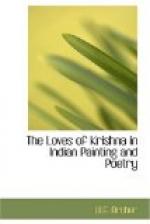The first reference to Krishna occurs in the Chandogya Upanishad of perhaps the sixth century B.C. Upanishads were ‘forest sittings’ or ‘sessions with teachers.’ Sages and their disciples discussed the nature of life and strove to determine the soul’s exact relationship to God. The starting-point was the theory of re-incarnation. Death, it was believed, did not end the soul. Death was merely a stepping-stone to another life, the soul moving from existence to existence in one long effort to escape re-birth. From this cycle, only one experience could bring release and that was consciousness or actual knowledge of the supreme Spirit. When that state was achieved, the soul blended with the Godhead and the cycle ended. The problem of problems, therefore, was how to attain such knowledge. The Chandogya Upanishad does not offer any startling solution to this matter. The teacher who conducts the session is a certain Ghora of the Angirasa family and it is the person of his disciple rather than his actual message which concerns us. The disciple is called Krishna and his mother has the name Devaki. Devaki is the later Krishna’s mother and there is accordingly every reason to suppose that the two Krishnas are the same. Nothing, however, is stated of this early Krishna’s career and although parts of the sage’s teachings have been compared to passages in the Gita,[3] Krishna himself remains a vague and dim name.
For the next few centuries, knowledge of Krishna remains in this fragmentary state. Nothing further is recorded and not until the great Indian epic, the Mahabharata, crystallizes out between the fourth century B.C. and the fourth century A.D. does a more detailed Krishna make his appearance.[4] By the end of this period, many vital changes had taken place. The Indian world-view had become much clearer and it is possible not only to connect Krishna with a definite character but to see him in clear relation to cosmic events. The supreme Spirit was now envisaged as a single all-powerful God, known according to his functions as Brahma, Vishnu and Siva. As Brahma, he brought into existence three worlds—heaven, earth and the nether regions—and also created gods or lesser divinities, earth and nature spirits, demons, ogres and men themselves. Siva, for his part, was God the final dissolver or destroyer, the source of reproductive energy and the inspirer of asceticism. He was thought of in many forms—as a potent ascetic, a butcher wild for blood, a serene dancer—and in his character of regenerator was represented by his symbol, the lingam or phallus. The third aspect, Vishnu, was God in his character of loving protector and preserver. This great Trinity was ultimately supreme but under it were a number of lesser powers. Those that represented the forces of good were called devas or gods. They were led by their king, Indra, lord of clouds, and associated with him were gods such as Agni (fire),




